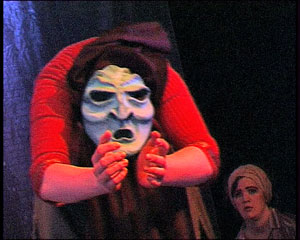Here is another post from the questionnaire from Stockholm Academy of Dramatic Arts. This time is about how I work with masks if I only use them in rehearsals and not in the actual play. For those who like to learn more about my workshops can go HERE.
When it comes to the influence the masks have over the actors in my shows, I have to specify with some examples. HERE is also a link to most of the shows that I have directed.
- In Commedia dell’Arte the masks already have their specific function. Even the poses and gestures of the characters are since the renaissance non-compromise able conditions for the persona of the masks. The poses, gestures, walks, rhythms, attitudes of the masks reflects their inner characters both for the actors and the audience. The mask and the body of the actor becomes a fast way into the character of the mask.
The mask also helps the actor to find the frenzy in Vulgar Comedy. In the size and the rhythm and speed that the masks demand, the actor soon land in the frenetic flow where actors and audience accept and follows in absurdities, insanities and absence of all perceptible logic.
This, strangely enough, also applies for the masks in Commedia dell’Arte that doesn’t wear a facemask.
In A Kela Commedia Extravaganza the masks played in every thinkable way, as puppets, on back of the actor’s head… in one scene the actor played seven different masks.
Click HERE or HERE to read more about the shows.
Or click HERE or HERE or HERE or HERE or HERE or HERE or HERE to see some of the video trailers from the shows. - In Snow White for Suckers the masks was more of caricatures, some of the dwarfs were also puppets. They worked more as “comic relief” and they did not influence the actor very much at all. Not even the actor’s bodies were formed by the masks.
- In Svarta Döden (The Black Death) the masks got the actors to move very slow, very obvious from the guts moving out to the limbs through the torso. It gave the actors authority and power. The actors also got a feeling of changes in their sense of time, it sort of slowed down.
- In Jag Drömmer – Alltså Dör Jag (I Dream – Therefore I Die) we only used one mask. The use of the mask is very interesting in this case. The character starts out as a demonic dream figure who first scares and the rapes, in a stylized manner, another character. But as the raped characters sounds transcends to laughter the masked character becomes full of shame, just to turn in to the quarantine inspector in Strindberg’s A Dream Play without ever taking of the mask.
The actor became fast, focused and grounded in the mask. It made the actor unreachable, dangerous and strong. The mask also legitimates the actor’s cruelty. When the scene changed and the character became shameful the actor felt a need to take of the mask. But instead of doing so we could use that need which is exactly how the quarantine inspector felt in the beginning of that scene.
Click HERE to see a video trailer from the performance. - In Eviga Berg (The Eternal Mountain), which was a children’s show, the mask work reminded in some parts of that with the Commedia dell’Arte masks, even though the masks were not as fast or articulate in the actor’s bodies. They also played more than one masked character.
Three sumo wrestlers become heavy and stupid. The actors, who sang and did a whole lot of acrobatics in the masks, had some problems with the weight the mask gave them (maybe also with the rhythm of the song).
Two of the other masks (a family of three women in different ages) might not have changed the actors much more then they would have changed them if they would have played the characters without mask, while the third mask (the grandmother) played the mask a lot. That doesn’t mean that the mask didn’t have their functions, but more about the functions of the mask in another post.

